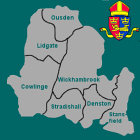  |
 |
 |
 |
 |
| Sat 17 Jan 2026 |

Church News Volume 7, Issue 9 (October 2006)Dear friends, We often find ourselves reminiscing about things that happened quite a long time ago, or being forced to listen to people who are anxious to tell us about things that involved them when they were children. We live in a nostalgic age, and we all know how boring that can be! Life can be full of reunions where folk can talk about shared experiences in the past. There is a magazine that caters for such things. So no doubt people who had gone out to listen to Jesus would look back to events of 50 years before and say - "Do you remember …?" That is how the Gospels came into being - what is called the oral tradition - and from that sprang the writings that we ascribe to Matthew, Mark, Luke and John. We can picture an old man telling how this vast crowd went out to listen to Jesus. How he walked about among them, talking, helping, healing. He couldn't have spoken loudly enough to be heard by everyone at once. He would have spoken to small groups, and later on when it dawned on everyone that they were hungry and far from sources of food he was the one who solved the problem. "We were hungry", the old man would say. "Suddenly the disciples were passing food around, a little boy went up to Jesus and gave him his picnic. The disciples even cleared up afterwards!" He would pause and then say: "It was a miracle!" This story of the feeding of the 5000 (in St Matthew chapter 14) can be looked at in several ways. It can be seen as part of the creative power of God. Jesus is God, living in his world and therefore he has all the power of creation at his command. One of his first temptations was to use that power to feed himself (turning stones into bread). In this story people may see that now he uses that power to feed the multitude. This is what the Gospel writers accepted. People can 'demythologise' the story. Jesus is the charismatic figure that creates in the crowd a desire to do good things. They are happy to share whatever they have. So he sits them down, says the blessing, and suddenly everyone seems to have food in their hands. It becomes a miracle of sharing. Or this story can be seen as a parable about sacramental things - that God uses the ordinary things of life to feed us. Not only with bread or fish, but with bread and wine. The story can be to do with the presence of Jesus among us in the sacramental life of the Church. These are three ways - all quite valid - that we may adopt to make sense to us of what the Gospels describe as a miracle. You will know what helps you best. The story of people being fed by Jesus brings home to us the fact that his ministry was involved in the everyday lives and needs of the folk around him. This is what incarnation means God being a human being, living in his world. On the one hand there are the secular things that surround us: work, home, all the terrible things we see on TV - pain, sickness, death. Think of them as represented by our left hand. Yet on the other hand there is what we are involved with here: worship of God, prayers, reading of the Bible - being brought close to God in the sacrament of Holy Communion. If we take these two sides of life and mesh our hands and fingers together we are putting our hands together in prayer. We are joining these two aspects of life - and we need to do so. This can be a striking illustration - like bringing together the hunger of 5000 people with the person of Jesus who (as in this sacrament) took, blessed, broke and gave. One hand on its own, the worldly side, cannot be sufficient, it needs the other hand, the person of God, to complete it. That is what sacraments tell us. We use the physical means of bread and wine to bring us the spiritual gifts that come from God. It is the joining of the material and the spiritual the putting of the hands together as we do when we pray. So the well-known story of the feeding of the 5000 can convey to us a variety of messages - perhaps the illustration of the hands joined in prayer can be one we take away with us today. Revd Ian M. Finn |

